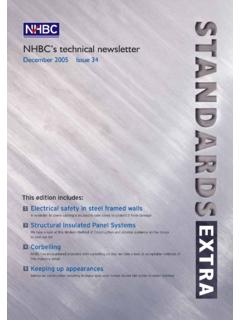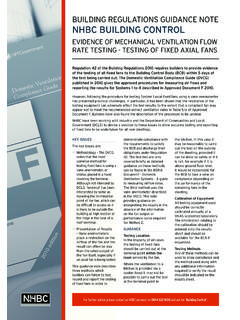Transcription of BEST PRACTICE SECTION 2 SUBSTRUCTURE GUIDES AND ... - …
1 BEST PRACTICE GUIDESSECTION 2 SUBSTRUCTURE AND DRAINAGESECTION 2 SUBSTRUCTURE AND DRAINAGES ection 1 of this series covered the importance of creating a solid foundation upon which to build a home. SECTION 2 takes this further and considers the SUBSTRUCTURE build - the part of the home that connects the structure above ground to the foundations. This includes walls, services, drains and the main ground floor - and all associated protection needed to prevent damp rising from the ground into the habitable area of the WALLS & COLUMNS WATERPROOFING & SUB-FLOOR GROUND FLOOR GAS PRECAUTIONSBEST PRACTICE GUIDES - SECTION 2 PAGE 2 0F 18 Our series of Best PRACTICE GUIDES will take you through what the Pride in the Job judges look for at each stage of construction and when considering the site manager s overall organisation and management skills.
2 The Pride in the Job marking sheet used by our judges has 44 marking lines split across 9 sections. The judges will give a score for each line - where there is no work to mark, that line will be left blank and no mark given. A mark of 4 indicates compliance with NHBC Standards and with Building Regulations. A mark of 5 indicates extra attention to detail over and above compliance standards. A mark of 6 would indicate that much of what the judges have seen cannot be improved upon. A mark less than 4 would indicate varying issues relating to workmanship and non-compliance with NHBC s Standards - the greater the issue or number of the same issue, the lower the mark.
3 The final score will be all the marks awarded expressed as a GUIDES set out what the judges are looking for with clear hints and tips on the sort of PRACTICE that will lead to higher marks. Clearly it is impossible in these short GUIDES to cover every single point of construction - we try here to cover the main issues that are taken into account when considering a mark for each score looking at the photographs, consider each on in the context of the score line heading - don t be distracted by something else that isn t as good - that will be marked accordingly PRACTICE - - - 3 BEST PRACTICE GUIDES - SECTION 2 PAGE 3 0F WALLS & WALLS & - - - - - - 6 BEST PRACTICE GUIDES - SECTION 2 PAGE 4 0F WALLS AND COLUMNS SPLAYED - - - - - 11 BEST PRACTICE GUIDES - SECTION 2 PAGE 5 0F 18888 BEST PRACTICE GUIDES - SECTION 2 PAGE 6 0F 19 SECTION 2 - SUBSTRUCTURE AND WALLS AND COLUMNS
4 Images 1 and 2: The masonry work is expected to be treated with the same attention to detail that it would be above ground; namely full joints in blockwork and brickwork, accurate cutting particularly on splayed bay work, square corners, full bonding wherever possible and clean cavities. In Image 1, one might query the spacing of the plastic vents - are they spaced at the right centres for example - and is there sufficient cross flow of ventilation. However, in this score line we are just looking at the masonry - issues with ventilation would be marked under score line 3 and 4: Continuing the theme of SUBSTRUCTURE walls and columns, the judges will look for consistent, neat and accurate service holes that take account of imposed loads from above, which means adequate bearing of any built-in lintels or core-drilled blocks.
5 Any in-situ reinforced concrete needs care taken with the placement of steel reinforcement with clean shuttering, especially in situations where the finished SUBSTRUCTURE walls will be unclad. Adequate vibration poker work will be evident on the finished surfaces of these walls. Image 3 would be improved by the bricks being laid frog up and the frogs filled. Consider how neat the work is in image 4. Images 5, 6 and 7: What marks would you give the work in these pictures? Although they are generally a solid build and would perform for the life of the building, the work lacks the finesse of the previous four photographs.
6 Image 5, in our opinion, although containing neat and clean work, lacks thought in relation to bonding, which has resulted in too many straight joints and would lose marks accordingly. Images 6 and 7 contain what we would consider to be industry average work and probably would only achieve a mark of 4 at best. The blocked air vents in image 7 would be marked down in line contrast in the workmanship shown in the images in this SECTION illustrates the meaning of Pride and the close attention to detail that is required of winning site managers.
7 Images 8 and 9: The work in these images would obviously not score well for Pride in the Job and indeed would warrant a mark of 3 or even 2 as they are well below industry average with serious remedial and re-build works required. Witnessing workmanship like this would raise a query as to the presence of a quality control system on site and the potential need for training or tool box talks. Images 10 and 11: Splayed bays are one area in SUBSTRUCTURE walls where opportunities to score additional points are regularly missed.
8 It is recognised by our judges that this is a difficult element to build in the best way possible, as it requires angle cutting of blockwork. If effort can be witnessed in this area, then the attention to detail and the effort will be rewarded. Image 10 is an obvious demonstration of the use of pre-cut and stuck corners on both leaves of masonry and this represents the ideal, aside from this standard of cutting actually being achieved on site. Clearly the frogs here have yet to be filled. Image 11 is a good, above-average 12, 13 and 14: These show a range of differing build standards with a range of issues in several of the examples - such as poor cuts, poor jointing, missing DPM and insufficient wall ties.
9 None of this work would be scored highly by the WATERPROOFING AND - - - - - - 17 BEST PRACTICE GUIDES - SECTION 2 PAGE 7 0F 188 BEST PRACTICE GUIDES - SECTION 2 PAGE 8 0F 19 SECTION 2 - SUBSTRUCTURE AND WATERPROOFING AND VENTILATIONI mages 15, 16 and 17: A very important part of any build is the prevention of moisture ingress into the building from the ground. Damp proof courses should be continuous and over the full width of the brick or block and must be located at the correct levels. A common fault is to sit the DPC back in the joint, which then allows rising damp to bypass it and show in the masonry above DPC.
10 Any tanking must be applied and installed in accordance with the manufacturers recommendations with particular attention paid to laps corners and fillets. Judges will look at the adequacy of sub-floor ventilation and achieving a good cross-flow to ensure minimal build-up of moisture in the floor void, in addition to allowing the free ventilation of any other gases that may build-up beneath the building. Telescopic ventilators are the most common form of sub-floor ventilation used, and it s important they are well jointed to ensure it s the sub-floor that s ventilated and not the base of the cavity.










